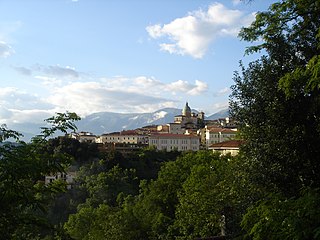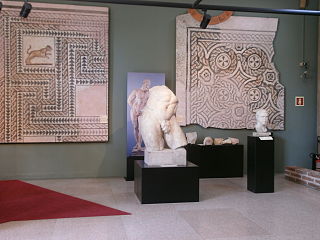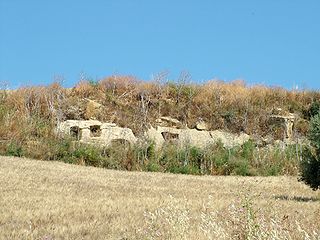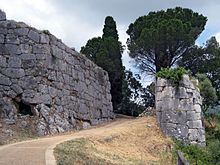
The Appian Way is one of the earliest and strategically most important Roman roads of the ancient republic. It connected Rome to Brindisi, in southeast Italy. Its importance is indicated by its common name, recorded by Statius, of Appia longarum... regina viarum.

Ascoli Piceno is a town and comune in the Marche region of Italy, capital of the province of the same name. Its population is around 47,000 but the urban area of the city has more than 93,000.

Lanuvium, modern Lanuvio, is an ancient city of Latium vetus, some 32 kilometres (20 mi) southeast of Rome, a little southwest of the Via Appia.

Segni is an Italian town and comune located in Lazio. The city is situated on a hilltop in the Lepini Mountains, and overlooks the valley of the Sacco River.

Spello is an ancient town and comune (township) of Italy, in the province of Perugia in east central Umbria, on the lower southern flank of Mt. Subasio. It is 6 km (4 mi) NNW of Foligno and 10 km (6 mi) SSE of Assisi.

Alatri is an Italian town and comune of the province of Frosinone in the region of Lazio, with c. 30,000 inhabitants. An ancient city of the Hernici, it is known for its megalithic acropolis.

Velletri is an Italian comune in the Metropolitan City of Rome, approximately 40km to the south-east of the city centre, located in the Alban Hills, in the region of Lazio, central Italy. Neighbouring communes are Rocca di Papa, Lariano, Cisterna di Latina, Artena, Aprilia, Nemi, Genzano di Roma, and Lanuvio. Its motto is: Est mihi libertas papalis et imperialis.

Ardea is an ancient town and comune in the Metropolitan City of Rome, 35 kilometres south of Rome and about 4 kilometres from today's Mediterranean coast.
Antemnae was a town and Roman colony of ancient Latium in Italy. It was situated two miles north of ancient Rome on a hill commanding the confluence of the Aniene and the Tiber. It lay west of the later Via Salaria and now lies within a park in modern Rome.

Saturnia is a spa town in Tuscany in north-central Italy that has been inhabited since ancient times. It is a frazione of the comune of Manciano, in the province of Grosseto. Famous for the spa which gives it its name, its population is 280.

Satricum, an ancient town of Latium vetus, lay on the right bank of the Astura river some 60 kilometres (37 mi) SE of Rome in a low-lying region south of the Alban Hills, at the NW border of the Pontine Marshes. It was directly accessible from Rome via a road running roughly parallel to the Via Appia.

Amelia is a town and comune of the province of Terni, in the Umbria region of central Italy. It grew up around an ancient hill fort, known to the Romans as Ameria.
Polygonal masonry is a technique of stone wall construction. True polygonal masonry is a technique wherein the visible surfaces of the stones are dressed with straight sides or joints, giving the block the appearance of a polygon.

Atina is a town and comune in the province of Frosinone, Lazio region of central Italy.

Old Latium is a region of the Italian peninsula bounded to the north by the river Tiber, to the east by the central Apennine mountains, to the west by the Mediterranean Sea and to the south by Monte Circeo. It was the territory of the Latins, an Italic tribe which included the early inhabitants of the city of Rome. Later it was also settled by various Italic tribes such as the Rutulians, Volscians, Aequi, and Hernici. The region was referred to as "old" to distinguish it from the expanded region, Latium, that included the region to the south of Old Latium, between Monte Circeo and the river Garigliano – the so-called Latium adiectum. It corresponded to the central part of the modern administrative region of Lazio, Italy, and it covered an area measuring of roughly 50 Roman miles. It was calculated by Mommsen that the region's area was about 1860 square kilometres.
Valvisciolo is a historical location in Latium, Italy, close to Sermoneta and Latina. Known mainly for the Valvisciolo Abbey, this locality also includes important archaeological remains of a prehistoric, hillside settlement at the Valvisciolo/Caracupa site. The site is a terraced settlement utilizing megalithic architecture, perhaps in technical terms an early predecessor of the more developed polygonal masonry of the later first millennium BC. Occupation on the site ends in the sixth century BC, with local populations perhaps shifting to the Latin city of Norba which was incorporated as a Latin colonia by 492 BCE, according to the textual tradition, mainly based on the historian Livy.

The Archaeological Museum of Milan is located in the ex-convent of the Monastero Maggiore, alongside the ancient church of San Maurizio al Monastero Maggiore, with entrance on Corso Magenta.

The Arch of Hadrian is an ancient Roman triumphal arch located in Santa Maria Capua Vetere. It was originally a triple arch, but today only three pylons and one of the lateral arches survive. It spanned the Appian Way and constituted an ideal entrance to the city, perhaps corresponding to the line of the pomerium.

The Appian Way Regional Park is the second-largest urban park of Europe, after Losiny Ostrov National Park in Moscow. It is a protected area of around 4580 hectares, established by the Italian region of Latium. It falls primarily within the territory of Rome but parts also extend into the neighbouring towns of Ciampino and Marino.

The archaeological park of Sabucina, located on the mountain of the same name near Caltanissetta, is an archaeological site in Sicily. The area contains settlements ranging from the Bronze Age to the Roman period.





















